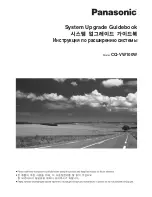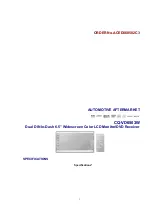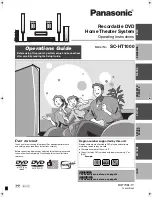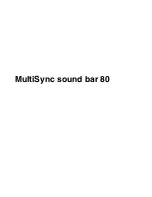
proportioned as tiny speakers can
be, beckoned from their perches in
the back of the room.
There’s no law of physics nor
any pending Constitutional amend-
ment that I’m aware of declaring
that speakers must look average
at best and toad’s-butt ugly if at
all possible. But our collective
puritanical background subcon-
sciously forces most red-blooded
Americans to be highly suspicious
of any component that even has
a whiff of style about it (Apple’s
iPod being a giant–or, more accu-
rately, a tiny–exception to the rule).
Our feelings run much the same
with people. Geeky nerds aren’t
expected to be the best dressed
guys at the lunch buffet; and, well,
I don’t really think Paris Hilton
reads Foreign Affairs, either.
Some misguided people are
going to dismiss these Mythos
beauties as just another collection
of pretty faces with no substance to
them–and they’d be wrong. Stulti-
fyingly wrong. If Def Tech had just
jumped on the rapidly moving
lifestyle bandwagon and simply
crammed a few basic drivers inside
a cabinet cosmetically tailored to
appeal to the flat-panel TV-buying
crowd, then none of this would
matter. The fact is that, while
Def Tech most admittedly designed
these speakers around a contempo-
rary cosmetic concept, they also
used their engineering prowess
to breathe silky sonic life into
their creation.
No Peaking
Here’s an example of what I’m
talking about. Def Tech engineered
the Mythos Fours, Threes, and
“pinpoint accuracy,
incredibly intimate
detail ... in a word:
three-dimensional
and thrilling”
“The system’s
blending of bass
and beauty is
quite astounding”
AT A GLANCE
DEFINITIVE TECHNOLOGY MYTHOS FOUR SPEAKER SYSTEM
HT Labs Measures: Definitive Technology
Mythos Four Speaker System
These listings are based on the manufacturer’s stated specs;
the HT Labs box below indicates the gear’s performance on
our test bench.
SUBWOOFER: SUPERCUBE II
Connections:
Speaker- and line-level
ins and outs, LFE in
Enclosure type:
Passive radiator
(two, 8 inches)
Woofer (size in inches, type):
8, long-throw polymer
Power Rating (watts):
1,250
Crossover Bypass:
Yes
Available Finishes:
Piano Black Gloss
Dimensions (H x W x D, inches): 12.5 by 12 by 12
Weight (pounds):
38
Price:
$899
SPEAKER:
Type:
Tweeter (size in inches, type):
Woofer (size in inches, type):
Radiator (size in inches, type):
Nominal Impedance (ohms):
Recommended Amp Power (watts):
Available Finishes:
Dimensions (H x W x D, inches):
Weight (pounds):
Price:
Mythos Four
2.5 way, tower
1, aluminum dome
4.5, cast basket (4)
4.5, planar bass (2)
4–8
20–225
Silver or Black
44 by 5.19 by 5.13
24
$699
Mythos Three
Two-way, center
1, aluminum dome
4.5, cast basket (2)
4.5, planar bass (2)
4–8
10–200
Silver or Black
5.4 by 25.1 by 4.2
15
$499
Mythos Gem
Two-way, monitor
1, aluminum dome
3.5, wide dispersion (2)
N/A
4–8
10–200
Silver or Black
10.25 by 4.25 by 4.125
5
$249
Mythos Four L/R Sensitivity:
87.5 dB from 500 Hz to 2 kHz
Mythos Three Center Sensitivity:
89 dB from 500 Hz to 2 kHz
Mythos Gem Surround Sensitivity:
87 dB from 500 Hz to 2 kHz
This graph shows the quasi-anechoic (employing
close-miking of all woofers) frequency response of
the Mythos Four L/R (purple trace), SuperCube II
sub (blue trace), Mythos Three center (green
trace), and Mythos Gem surround (red trace). All
passive loudspeakers were measured at a distance
of 1 meter with a 2.83-volt input and scaled for dis-
play purposes.
The Mythos Four’s listening-window response
(a five-point average of axial and +/–15-degree
horizontal and vertical responses) measures
+2.77/–1.26 dB from 200 Hz to 10 kHz.The -3dB
point is at 104 Hz, and the -6dB point is at 90 Hz.
Impedance reaches a minimum of 4.82 ohms at 267
Hz and a phase angle of -30.34 degrees at 162 Hz.
The Mythos Three’s listening-window response
me0.95/–2.91 dB from 200 Hz to 10 kHz.
An average of axial and +/–15-degree horizontal
responses me0.97/-2.98 dB from 200 Hz
to 10 kHz.The –3dB point is at 122 Hz, and the
–6dB point is at 106 Hz. Impedance reaches a mini-
mum of 3.96 ohms at 251 Hz and a phase angle of
–46.45 degrees at 158 Hz.
The Mythos Gem’s listening-window response
me1.52/–2.17 dB from 200 Hz to 10 kHz.
The –3dB point is at 162 Hz, and the –6dB is at
134 Hz. Impedance reaches a minimum of 4.68
ohms at 343 Hz and a phase angle of –51.06
degrees at 183 Hz.
The SuperCube II’s close-miked response, nor-
malized to the level at 80 Hz, indicates that the
lower –3dB point is at 27 Hz and the –6dB point is
at 25 Hz. the upper –3dB point is at 110 Hz when
using the LEF input. —
MJP






















